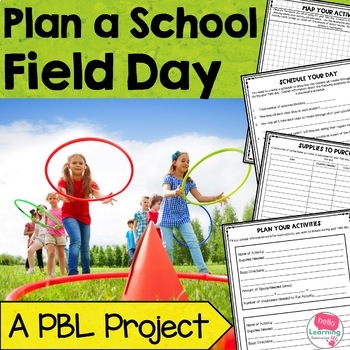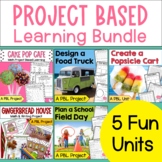Plan a Field Day Project Based Learning (PBL)
- PDF
What educators are saying
Also included in
- Your students will love working on the real world math project based learning units included in this bundle! Use these PBL math projects as authentic assessments, end of unit activities or as fun multi-disciplinary units. Perfect for 4th and 5th grade!Save 25% off the price of the individual resourPrice $19.97Original Price $26.15Save $6.18
Description
Plan a School Field Day is an engaging project based learning (PBL) activity that puts your students in charge of planning their own field day. This student centered math, health and ELA PBL unit encourages students to plan and organize a field day through problem solving, collaboration, research, creativity and math, health and ELA skills.
This project based learning unit focuses on applying the skills of adding decimals, area, scale, measurement, intervals of time, first aid, reading informational text, expository writing, inquiry and research, communication, collaboration and scheduling.
This PBL project is broken up into six sections
- Field Day Basics- Students will plan the date, time and location of the field day, and decide who will be invited.
- Field Day Activities- Students will brainstorm, select and plan 6-8 activities for others to enjoy during their field day. They will calculate the area needed for each activity, write directions for their activities and determine the supplies they need.
- The Supplies- Students will create a list of the supplies they will need for their field day plan. They will determine what supplies they can borrow, and what they will need to purchase. Students will research the cost of items to purchase and calculate the total expense of supplies.
- Mapping the activities- Students will measure the area where they plan to hold field day. Next, they will determine a scale for their map and use that scale to draw boundaries and make a layout for where each activity/event will be located.
- Field Day Schedule- Students will use the number of activities planned and the number of classes invited to plan a schedule for when each class will participate in each activity. Intervals of time will be used to keep a flow between activities.
- Field Day Safety- Students will research first aid procedures for minor scrapes/cuts, bruises, insect stings and bloody noses. They will write procedure reference cards to put in first aid kits to have at field day.
Ideas for an entry event and extensions are also included!
What is included?
- project overview
- entry event ideas
- teacher layout/information plan for each section
- student pages for each section
- examples for making a map to scale and creating a schedule
- end of unit student reflection
- end of unit grading rubric
Do all six sections or pick and choose the sections that work best for your class!
You may also like my:
Design a Dream Bedroom Project
Geometry City Angles and Lines Project
Follow me and be notified when new products are added to my store. New products are always 50% off for the first 24 hours they are posted!






